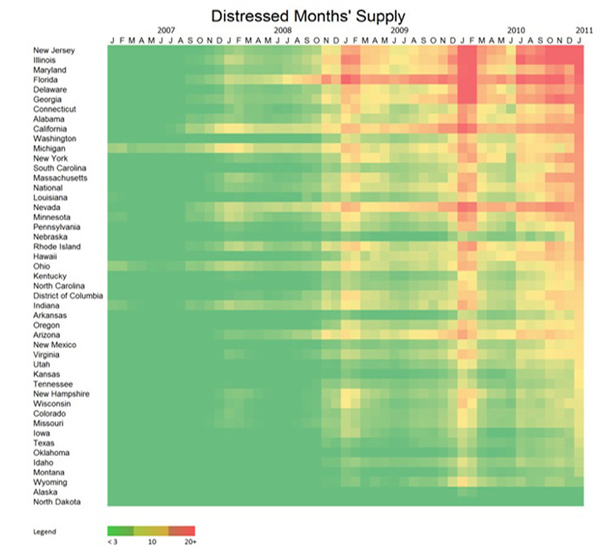Between the recent report that sales of new homes hit a record low in February and this week's news that 19 of the 20 largest metro areas tracked by the Standard & Poor's/Case-Shiller home price index saw a price slump in January, it hasn't exactly been a stellar few weeks for the housing market. And yet another data dump tracking foreclosed and distressed homes that have yet to hit the markets - what's known as "shadow inventory" - suggests things are not likely to get a whole lot better for a long time.
Supply Sigh Economics
More robust economic growth, a pickup in job creation (and wage growth), and a renewed desire by banks to actually write mortgages are all central pieces of any housing rebound. Job growth last month was indeed stronger than in past months, and a new survey of CEOs finds them increasingly upbeat about hiring. But even if those green shoots emerge, it may take a whole lot longer to see any pickup in home values given the alarming backlog of homes currently on the market, as well as homes that may soon be for sale.
 |
| Sign of the times in some markets |
In terms of homes for sale, we have three inventory tracks to keep an eye on:
* The official inventory: 3.5 million homes. The National Association of Realtors says the current inventory of existing homes that are listed for sale would take 8.6 months to work down at the current sales pace. In "normal" times, the inventory backlog is more in the vicinity of six months.
* The unofficial shadow inventory: 1.8 million homes. According to research firm CoreLogic, there's another 1.8 million homes sitting in shadow inventory. These are homes that don't yet show up in NAR's Multiple Listing Service as being for sale, but that are likely to hit the market at some point. They include homes that banks have already foreclosed on but have yet to put up for sale, homes that are somewhere in theforeclosure process, and homes in which owners are at least 90 days late on their mortgage payments. CoreLogic estimates that those 1.8 million homes represents an additional 9 months of potential supply given the pace of how bank-owned property and pending foreclosures make their way to market.
* The severely underwater inventory: 2 million. CoreLogic uses this category to refer to homeowners that are at least 50 percent underwater on their mortgages. Now there's nothing that says homeowners with negative equity will in fact walk away from their mortgages. But it's reasonable to presume that short of a quick turnaround in home values or a settlement between the state attorneys general and lenders that leads to substantial loan modifications, a significant chunk of these homes will end up on the market in the coming months or years.
Add it all up, and NAR's 8.6 month official backlog triples to about two years or so.
Distress Points
To get a sense of where your housing market stands, take a look at CoreLogic's comparison of each state's tally of mortgages that are at least 90 days late to its current sales rate. The states with the most distressed housing inventory are New Jersey, Illinois, Maryland, and Florida, while those with the least distressed inventory are North Dakota, Alaska, Wyoming, and Montana.
Of course, even state-level data doesn't capture what's going on in your local area. If you're looking to buy or sell, one important step at this juncture is to look beyond the official sales and inventory data, and try to get a sense of local shadow inventory. This is where a solid and straight-up real estate agent is going to be crucial. You don't want sugarcoating; you need an honest assessment of what's in your local pipeline.
The fact that your local market has a large shadow inventory doesn't necessarily mean more steep price declines. But if there is indeed a big backlog of shadow inventory, it's hard to make a case that home values will rebound any time soon given the large supply that needs to come to market and be absorbed.
If you're looking to buy, a high shadow inventory is seemingly an argument to take your time looking, but keep all the moving pieces of this in mind. For example, even if you don't have to worry about rising prices, what about mortgage rates? No one can predict where mortgage rates will be in six months or a year, but we do know that current rates are at historic lows. As for sellers, well, if you really want to sell and you find you are in an area with a lot of shadow inventory, waiting might not be in your best interests. Even if prices stabilize, working through that backlog could make it a while before prices start to climb again.
 |
| States with the most distressed properties are expressed in red Source: CoreLogic |











